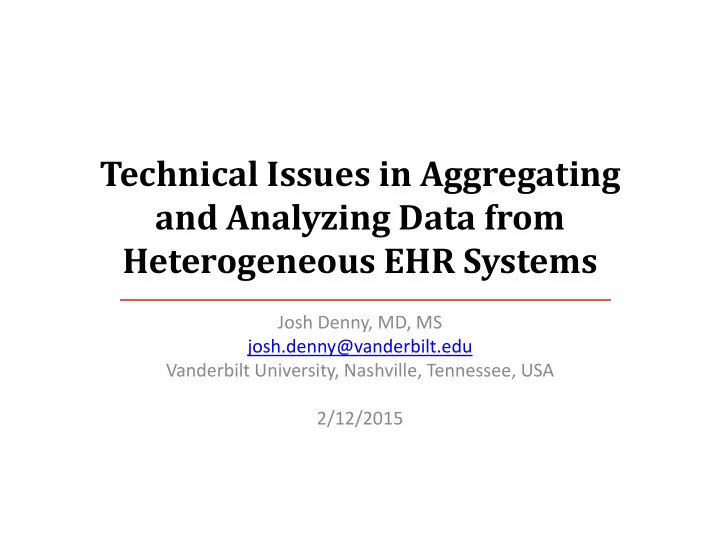

Technical Issues in Aggregating and Analyzing Data from Heterogeneous EHR Systems Josh Denny, MD, MS josh.denny@vanderbilt.edu Vanderbilt University, Nashville, Tennessee, USA 2/12/2015
EHR data are dense 196,693 individuals in an EHR DNA Biobank (BioVU) • Mean follow ‐ up – 5.7 yrs • Distinct ICD9 codes – 19 million • Labs – 121 million – Distinct labs – 5948 – Avg labs/patient – 662 • Drugs – 122 million • Notes – 26 million (average 132 notes/individual) • Radiology tests – 2 million
Approach to EHR phenotyping PPV<95% PPV Deploy at Genetic ≥ 95% site 1 Case & control association Identify Manual algorithm tests; phenotype review; assess development and replicate of interest Validate precision refinement at other sites Extant Genotypes
What we’ve learned ‐ Finding phenotypes in the EMR Clinical Notes Billing codes (NLP - natural language ICD9 & CPT processing) True cases Medications ePrescribing Labs & test results & NLP NLP
Finding cases: Rheumatoid Arthritis Excluded Definite Cases (algorithm-defined) (algorithm-defined) Possible Cases Controls (require manual review) (algorithm-defined) 255 507 7121 1184 Optional Manual Review Analysis
Replicating known studies in the EHR published observed gene / disease marker region rs2200733 Chr. 4q25 Atrial fibrillation rs10033464 Chr. 4q25 rs11805303 IL23R rs17234657 Chr. 5 Crohn's disease rs1000113 Chr. 5 rs17221417 NOD2 rs2542151 PTPN22 rs3135388 DRB1*1501 Multiple sclerosis rs2104286 IL2RA rs6897932 IL7RA rs6457617 Chr. 6 Rheumatoid arthritis rs6679677 RSBN1 rs2476601 PTPN22 rs4506565 TCF7L2 rs12255372 TCF7L2 rs12243326 TCF7L2 rs10811661 CDKN2B Type 2 diabetes rs8050136 FTO rs5219 KCNJ11 rs5215 KCNJ11 rs4402960 IGF2BP2 0.5 1.0 2.0 5.0 Odds Ratio Am J Hum Genet. 2010;86:560 ‐ 72.
Discovery science in eMERGE Algorithms can be deployed across multiple EMRs Analyses can be performed using extant data Am J Hum Genet. 2011;89:529-42
Completed eMERGE GWAS Diseases Endophenotypes Selected consortia contributions • Dementia • PR Duration Height • • Cataracts • QRS Duration QTc • • Autoimmune Hypothyroidism • HDL/LDL Rheum. Arthritis • • Diverticulosis/ diverticulitis height • Myocardial Infarction • Type 2 Diabetes white blood cell counts • • Genetics Consortium Diabetic retinopathy red blood cell counts • • • Intl. Mult Sclerosis Genet. Herpes zoster Cardiorespiratory Fitness • • Consort. PheWAS ESR levels • • • Genomic Investigation of • Peripheral Arterial Disease • Platelet levels Statin Therapy Venous Thromboembolism • • Glaucoma Pharmacogenomic phenotypes • Ocular hypertension • ACE inhibitor cough • Abdominal Aortic Aneurysm • Heparin induced thrombocytopenia • Colon polyps • Resistant hypertension • Drug Induced Liver Injury bold =GWAS completed with • C. difficile colitis significant results
85 phenotypes from eMERGE, PGRN, PCORnet 47 have validation data 118 total implementations
Hypothyroidism algorithm
Performance of 88 Phenotype Algorithms in PheKB 100% Positive Predictive Value 80% Site Implementations 60% Drug-induced Median liver injury 40% 20% 0% Primary site Secondary sites Positive Predict Value
The genome ‐ wide association study association Example new PheWAS P value Target associations for IRF4 Known: hair, skin, eye color phenotype chromosomal location The phenome ‐ wide association study association Target P value genotype diagnosis code PheWAS requirement: A large cohort of patients with genotype data and many diagnoses
Phenotype Cases Controls Studying drug Clopidogrel in CV disease 225 468 Warfarin stable dose 1,167 N/A Early Repolarization 544 2,609 responses with Vancomycin stable dose 1,067 N/A C. difficile colitis 941 1,710 Anthracycline cardiomyopathy 528 N/A GWAS Guillain-Barre Syndrome 97 6,536 Heart Transplant 181 N/A Kidney transplant 1,078 N/A Clopidogrel in strokes/TIAs 6 123 Statin-related myopathy 11 4,342 Heparin-induced thrombocytopenia 73 2,300 CV events with COX2 therapy 85 395 “Only” about 120,000 Serious bleeding during warfarin 259 276 samples at time of study Amiodarone toxicity (lung, thyroid) 97 343 Chronic inflammatory – underpowered for 12 14,000* polyneuropathy many rare outcomes Rheumatic Heart Disease 108 3,464 ACEi cough 1,174 978 Fluoroquinolones and tenopathy 87 537 Warfarin stable dose in children 92 N/A Metformin efficacy 80 N/A 90% participated in Metformin and cancer 619 421 Bisphosphonates and Atypical >1 study 16 1,454 Fracture/Jaw Osteonecrosis Wolff-Parkinson-White 197 5,551 Steroid-induced Osteonecrosis 83 352 Shellfish Anaphylaxis 157 14,000* Aspirin Anaphylaxis 101 4,334 Bell's Palsy # 577 14,000* Bowton et al., Sci Trans Med. 2014
Strengths • Rich, longitudinal data stores • Ability to go back to the chart to find out more • Research ‐ quality phenotypes available via algorithms • Potential for closed ‐ loop discovery and implementation • Expensive testing available “for free” • Ability to explore rare, detailed, drug ‐ response, and mortal phenotypes • Samples easily reused for many studies
Challenges • Developing algorithms takes time and people, and then implementation requires local expertise • EHR data can be inaccurate, heterogeneous, unavailable, lack organization, have different storage structures • Fragmentation between healthcare systems • Mining of EHR data is not trivial (though improving): text data, duration and temporality
How do you share genetic data? Site 1 Site 1 Site 2 Site 5 Coordinating Site 5 Site 2 Center Site 4 Site 3 Site 3 Site 4 Edges (unique DUAs): n(n ‐ 1)/2 = 10 Edges: n = 5 10 sites = 45 vs. 10 20 sites = 190 vs. 20 30 sites = 435 vs. 30
Kaiser Permanente Network DNA samples GWAS eMERGE 361k 51k (100k) Coordinating Center Million Veterans Program 350k 200k Kaiser Permanente 300k 100k : pediatric sites Total >1 million >351k
Recommend
More recommend